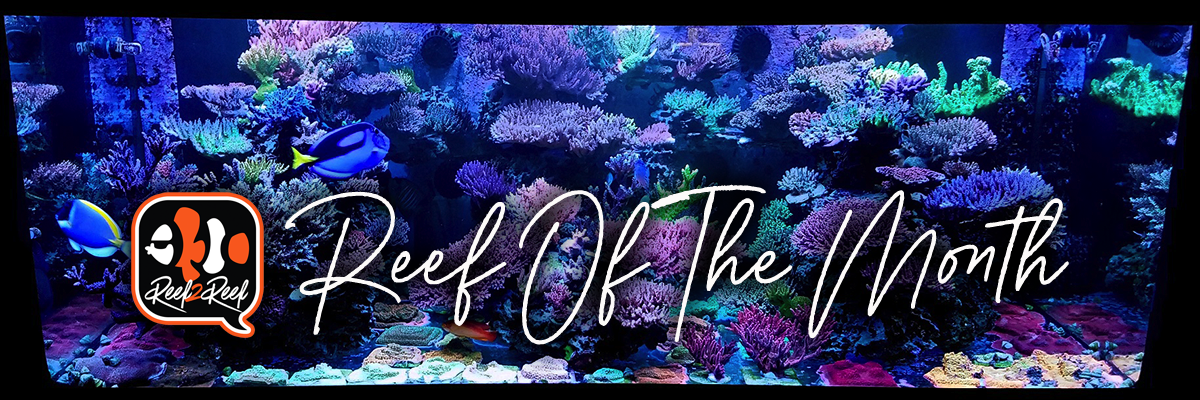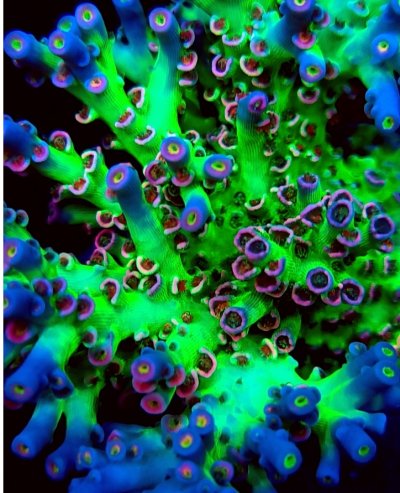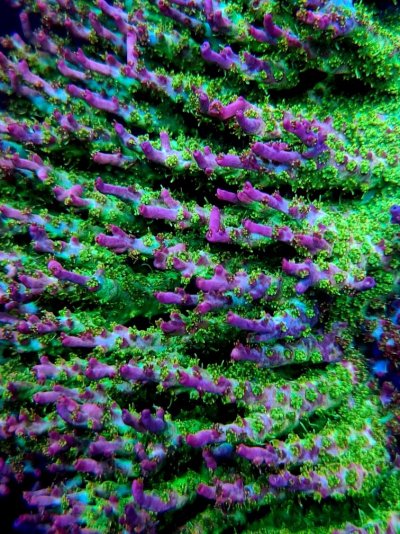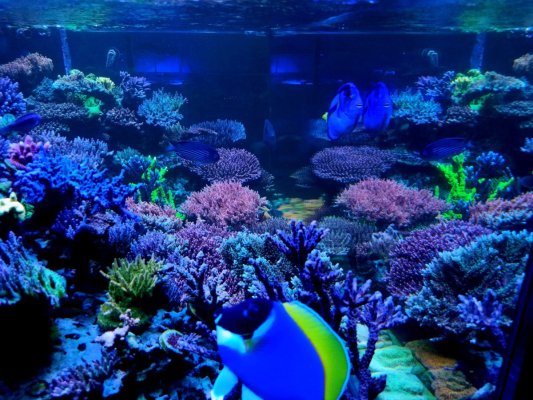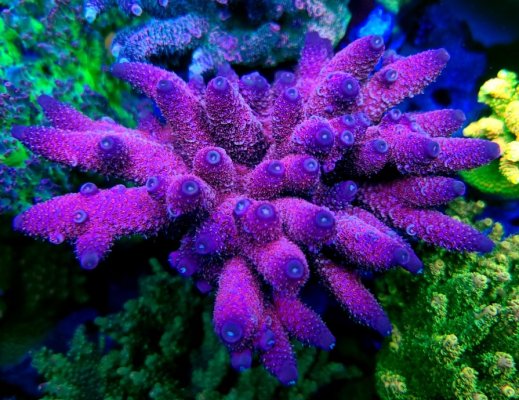Introduction:
It’s an honor to be selected as Reef of the Month on R2R! My name is Graham and I’ve been reef keeping for over 15 years now. I’ve always been fascinated with the plant and animal kingdom and have kept aquariums since I was a child. My first aquarium was a basic 10-gallon freshwater tank which I got immense enjoyment out of and learned very much from. However, I was always drawn towards the colors of the saltwater fish when my mom would take me to our LFS. Her encouragement and support for my passion of natural things very much shaped who I am today.
When I graduated college in 2006, I finally had the means to set up a saltwater tank which was a 55-gallon mixed reef. I would spend hours in front of the tank watching the fish and corals bask under the shimmer of the 10k metal halides. It felt like being transported to a real reef far away. I do miss the natural look and feel of those now archaic lights.
This was the start of my reef keeping obsession which has now grown to include three systems totaling about 1500 gallons of actual water volume. In the first few years of my reefkeeping career my focus quickly narrowed to aquaculturing coral, primarily SPS. I naturally gravitated towards SPS as I was always amazed and inspired by the colors and structures others were able to achieve with SPS dominated tanks. Early on I upgraded to a 90-gallon tank which grew out in a couple years once I figured out how to successfully keep SPS. At that point I started plumbing in frag tanks to allow me to grow more coral. I get so much fulfillment out of the challenge and reward of growing corals. After several more years my growth rate started to exceed the rate at which I could expand my systems while still living in an apartment. At this point I started dabbling in selling corals. Fast forward to today and I’m now able to pay for the expenses of the hobby with the money I make from selling coral.
I have a full-time job as a Mechanical Engineer, so coral sales at this point are just something on the side to pay for hobby expenses. Ultimately, I’d like to retire early and transition this endeavor to a full-blown business with a website. Currently, time is my limiting factor. My wife and I both have full-time jobs, a rambunctious puppy, three cats, and a house surrounded by planted gardens. She grows orchids and I grow bonsai trees as well. All of which are time consuming and require significant maintenance. My wife is very supportive and takes on a lot so that I can spend sufficient time maintaining the tanks which is extremely time consuming for one person given the breadth of the systems.
Back to the tank being featured. I set up this 300-gallon tank in 2014 as my main display tank. We had purchased our house the prior year which has a 1400 sq ft unfinished basement with 9-foot ceilings. I finally had a reefkeeping man-cave, this was the true enabler to expanding to a much larger reefkeeping operation!
System Profile:
- Display tank: Marineland 300DD
- Glass or Acrylic: Glass
- Stand: DIY (dimensional lumber / plywood finished with enamel paint)
- Sump: Trigger Systems Ruby Sump 36
- Grow-out tank: Two 36”x36”x10” Glass Cages frag tanks
- Protein skimmer: Super Reef Octopus XP5000
- Carbon/phosphate filtration: None, small amount of LaCl dosed into skimmer to control PO4 levels as needed
- Return pump: Fluval SP6
- Water circulation: 4X Ecotech MP40s, 2X Tunze 6105s
- Lighting (display): 6X Radion XR30 G5 Blues, 2X 60” Reefbrite XHO Blues, 4X 60” 80W ATI Blue Plus T5s
- Lighting (grow-out): 4X Radion XR15 G5 Blues and 2X 30” XHO Blues per tank
- Lighting (refugium): 2X 20W 6,000K LED Flood Lights on ATS
- Calcium/alkalinity/magnesium dosing equipment: Geo 624 Calcium Reactor
- Auto top-off: DIY with Madison M8000 float switches
- Heating/cooling: 3X 250W Eheim Jager Heaters / 4X Honeywell HT-900 Fans
- System control: Neptune Apex Classic
Water Circulation and Flow Summary and Objectives:
My primary objective with water circulation is to provide sufficient flow to keep SPS thriving throughout the entire tank while not visually polluting the front and side panes with powerheads. All the powerheads are on the rear pane of the tank. When I created the aquascape I wanted three bommies, this decision was partially driven by lighting options and the opaque braces on the top of the tank. I bridged these bommies together with shelf rock and did so in a manner that allowed me to position four MP40s strategically on the back of the tank. This created channels for the water to flow straight forward through with rockwork on all sides that I could mount SPS to. I achieve sufficient flow throughout the tank, but to be honest in a few places it’s more unidirectional than I would prefer. To create more turbulent flow, I believe I would need to have powerheads mounted to the sides of the tank which I prefer to avoid. This is a compromise between function and aesthetics, which as we know is a common challenge for reef keepers.
Here is the tank as it started.

Here it is grown in today.

Here it is grown in today.
Water Parameters:
- Temp: 77.0 – 78.0 F
- pH: 7.7 – 8.1
- Specific gravity: 33.0 – 33.5 ppt
- NO3: 1 – 5 ppm
- Ca: 430 - 440 ppm
- Alk: 7.7 – 8.2 dKh
- Mg: 1300 – 1400 ppm
- PO4: 0.05- 0.15 ppm
- Ammonia and nitrites: 0
I use Instant Ocean. I have three reef systems totaling approximately 1500 gallons and perform 20% water changes every other week religiously. I pick up a pallet of Instant Ocean annually (40X 200G boxes) and this matches my consumption very well. I’ve tried more expensive salts before (Red Sea Blue Bucket for example), but did not observe any long term benefits. I also prefer not to use salt with elevated levels such as alkalinity. For maximum stability, I believe you want to replace existing saltwater with saltwater of the same parameters, namely alkalinity. Otherwise, you are introducing an alkalinity fluctuation or spike every time you perform a water change.
What kind of rock did you start with (live, dry, combination)?
For this display tank I used 100% dry rock form Marco Rocks. It was mostly large pieces and shelf rock. I used the Marco Rocks mortar kit to bond it all together. In hindsight I would have mixed in existing live rock or utilized bacterial additives to speed up the process. This tank took about 1.5 years for SPS to do well and about 2 years before SPS was thriving. If starting with established live rock I believe this timeframe could be reduced to as little as 6 months.
What is your substrate?
This tank is bare bottom as are all my tanks except for my upstairs display tank. I find bare bottom tanks are much easier to maintain. This tank is also entirely SPS, so I can turn up the flow much more than I’d be able to with substrate. I also cover most of the bottom with montipora to utilize the available real estate. It’s not the most natural look per se, and it also creates issues when the montipora start encrusting onto the rockwork, silicon seams and vertical panes of glass.
Calcium/Alkalinity/Magnesium Summary and Objectives:
Historically I run two-part on my systems. A few years ago, I switched this system over to a calcium reactor to see if it would result in better coral growth and/or colors. The setup includes a Geo 624, CarbonDoser, a medical grade peristaltic pump to control flow rate, and I control the reactor chamber pH with my Apex.
I always strive for a more natural approach with my reefkeeping husbandry, and I believe a calcium reactor is more natural than two-part. My thought process is that a calcium reactor is using coral skeleton to supply the elements to build coral skeleton. So, in this sense it is a natural solution with the addition and consumption of elements being balanced. Based on ICP-OES test results, I would say it does a better job than two-part at maintaining certain trace elements.
When dosing two part, I use ICP-OES test results to supplement Potassium, Strontium, and Iodine in the Calcium solution to maintain natural seawater levels for these parameters. With a calcium reactor these levels are maintained without supplementation, in my experience.
As far as color and growth are concerned, I do not see any observable difference between two-part and a calcium reactor.
I think the downside of a calcium reactor is the complexity and number of failure modes. With two part the only component that can really fail is the peristaltic pump. With the calcium reactor I’m already using a peristaltic pump to keep a consistent effluent rate, but it requires several additional components that could fail.
Whether refilling two-part containers or adding media to the calcium reactor I always need to turn down the peristaltic pump otherwise it results in a spike in alkalinity. For two part it’s due to the head pressure on the downstream side of the pump. With the calcium reactor it’s due to an increase in overall media as well as the new media dissolving more readily at the reactor pH. This impact in my experience is more substantial and harder to control with the Calcium reactor.
Currently I’m planning to switch this system back to two-part. Reliability and consistency is extremely important in this hobby, and I personally get better results in this regard with two-part.
Another aspect I have not touched on is cost. Over the years I have read a number of threads comparing the cost of a calcium reactor and two-part in great detail. Generally speaking, a calcium reactor has more equipment cost upfront but the media is cheaper and as a result will be cheaper in the long run. I’ve never worked out a cost comparison for my own use, but I’m not convinced it’s that significant (at least not until I just saw BRS prices on the 5-gallon buckets of two-part have almost doubled). With a calcium reactor I have to replace peristaltic tubing (PharMed is expensive) much more often due to effluent flow rates, and I have to stop by the local gas supplier to get CO2 every couple of months.
For me the ability to keep alkalinity stable and reduce points of failure is far more important than a minor cost difference between the two methods.
The other downside to a calcium reactor is the CO2 has a lowering effect on tank pH. I run the effluent into the skimmer intake to drive off excess CO2. On my systems with two-part I dose Sodium Carbonate which increased tank pH. When I compare systems, the ones on two-part maintain higher pH than the one with a calcium reactor. I think the vast majority of reef keepers are trying to increase pH as opposed to lower pH, so two-part has a distinct advantage here.
What and how do you dose for the big 3 (alk/cal/mag)?
I covered this in detail in the last section, but I didn’t touch on magnesium. With the calcium reactor I don’t need to supplement the magnesium, as it keeps up with consumption without dedicated magnesium additives. With two-part I add magnesium chloride to the calcium chloride solution. I also add strontium chloride, potassium chloride, iodine, and sometimes lanthanum chloride (to control phosphates) to the calcium chloride solution. I’m by no means a chemist, but I figure anything bonded to chloride before being dissolved isn’t going to react or precipitate out in the calcium solution.
Are you dosing anything else for your reef health (carbon dosing, aminos, etc.)?
Beyond trace elements I also dose Seachem Aquavitro Fuel in all three systems at one half the manufacturer’s recommended dosage. I’ve done this for many years with good results and will continue to do so. In one system I also dose Oyster Feast to keep nutrients up, but that stuff is quite expensive considering larger water volumes.
I also dose Lanthanum Chloride to control PO4 as needed. I currently shoot for 0.05-0.15 ppm PO4. I notice a reduction in growth when PO4 goes above 0.10 ppm. I used to run my systems at much higher PO4 levels, anywhere from 0.4-1.0 ppm PO4. Some SPS had better colors when nutrients were higher, some have better color under lower nutrients. But overall, I do find I get much better growth when I keep PO4 under 0.10 ppm. At one point PO4 in one of my systems hit 1.2 ppm and I observed a reduction in growth as well as browning on some SPS. At this point I decided to slowly lower my PO4 levels. I always dose LaCl (whether it’s part of my CaCl mix or independent) into my skimmer intake. My systems doesn’t require much LaCl to control PO4, but I don’t want to introduce the health risks to my fish associated with dosing LaCl directly into the tank water without filtration.
Lighting Summary and Objectives:
I’m a bit old school and ran 20k radium halides on most of my tanks until the end of 2020. Originally this tank was lit by one 400W radium, two 250W Radiums, four 60” 80W ATI blue plus T5s and two 60” Reefbrite XHO blues. I love the natural look and shimmer of metal halides but do firmly believe most SPS color up better under a much bluer spectrum. Halides of course create a lot of heat. It’s always been a challenge managing the heat and humidity generated by 1500 gallons of well-lit reef tanks.
At the end of 2020 I progressively replaced all my halides with Radion G5 Blues. Each halide fixture got replaced by two XR30s or four XR15s. In my findings a single XR30 produces less light and coverage than a 250W halide in a large reflector, but two XR30s produce more light and spread. This upgrade allowed me to achieve a lot more light on the shelf rock at the rear of the tank which was previously underlit for SPS to reach ideal coloration.
Overall, the corals responded very favorable when moving from halides to Radions. Colors significantly improved on many corals, as did growth, most likely from the increased coverage. However, I do miss the natural look of the halides. Also, photographing “white light” corals and fish is increasingly difficult under blue LEDs.
Photoperiod
- Display tank: 12 hours Reefbrite, 10 hours T5, 8 hours Radion with a 1 hour ramp up and down at either end / 6 hours peak
- Grow-out tank: 12 hours reefbrite, 8 hours Radion with a 1 hour ramp up and down at either end / 6 hours peak
- Refugium: ATS with lights that are on for 14 hours before primary reef lights turn on (pseudo reverse photoperiod)
Frag Tank

Filtration and Water Quality Summary and Objectives:
I try to keep things as simple as possible and take a more natural approach when I can. I run my skimmer 24/7. It really doesn’t pull much out anymore, which I suspect is because the fish, coral, snails, hermit crabs and other “naturally occurring” organisms (bacteria, sponges, and micro brittle stars) consume the vast majority of nutrients I introduce. At this point, I’m running the skimmer more for aeration and to maintain higher pH levels than for nutrient export. Import and export needs to be balanced for stability, increasing them while maintaining balance is almost always advantageous to the many reef organisms that depend on nutrient import for their energy needs.
What is your export strategy?
I try to avoid chemicals as much as possible and use a more natural approach. I use filter socks and run my skimmer 24/7 for mechanical export. I run a DIY algae turf scrubber (ATS). I perform 20% water changes religiously every other week. I do not run GAC or GFO. I dose a small amount of LaCL to keep PO4 levels as stable as possible within my targeted range
What is your maintenance routine?
Daily: Feed the fish and change filter socks as needed. Check on water levels and powerheads. Test alkalinity if my auto-testers report a value different than what I target. Adjust alkalinity and/or dosers as required.
Weekly: 20% water changes every other week. Constantly checking on and cleaning powerheads to maintain flow.
Tank Inhabitants—Fish:
- Powder Blue Tang
- Blue Tang
- Yellow Tang
- Desjardini Sailfin Tang
- Regal Angelfish
- Watanabei Angelfish
- Gold Stripe Maroon Clownfish
- 2X Blue Green Chromis
- Male Flame Wrasse
- Labout’s Wrasse
- Roseafascia Wrasse
- Red Mandarin Dragonet
- Astrea Snails
- Mexican Turbo Snails
- Banded Trochus Snails
- Scarlet Reef Hermit Crabs
- Mexican Blue Leg Hermit Crabs
- Nassarius Snails (not introduced, reproduce naturally)
- Micro Brittle Stars (not introduced, reproduce naturally)
- Too many to list...
Fish and Coral Feeding:
On Monday, Wednesday, and Friday, I feed frozen mysis cubes and nori. On Tuesday, Thursday, Saturday, and Sunday, I feed NLS pellets. Twice a week, I dose Aquavitro Fuel at 1/2 the recommended dosage.
How did you decide what to keep in your tank?
In my opinion, I think Acropora produce the best-looking display tanks. It’s also my focus when it comes to aquaculture. So naturally, I chose a SPS dominated display. Beyond that, I chose reef-safe fish that have the appearance and personality that appeal to me.
Any stocking regrets?
I can’t think of any stocking regrets other than attempting fish that have high mortality rates. For instance, a couple of times over the years I’ve attempted to introduce schools of anthias only to have deaths due to bacterial issues and/or aggression.
Any fish, invert, or coral you will NEVER keep?
I appreciate just about all fish, inverts, and corals, but will likely never keep softies and non-reef-safe fish.
What do you love most about the hobby?
Reefkeeping is an incredible hobby in that no matter how many years you do it for, there is always something you haven’t tried yet, and it continues to always be challenging. Between the vast diversity of marine life, and all the advances we have made with knowledge and technology, it simply never gets old!
How long have you been doing this?
I’ve been reefkeeping for about 16 years, keeping fish tanks for about 30 years, and will be an avid observer of the natural world until I die.
Who was responsible for getting you into the hobby?
Growing up, my parents provided plenty of opportunities for my sister and I to be involved with nature and keeping animals, so I credit them with enabling my fascination of the natural world which led me to reefkeeping.
Who or what in the hobby most influences/inspires you?
I’m most inspired by other hobbyists who are even more obsessed or have achieved a higher level of reefkeeping success than myself.
If you could have any tank, what size would it be and why?
If money were no object, I think my ideal tank would be along the lines of Pieter van Suijlekom’s 20-foot reef tank. Basically, as large as possible, but not so deep or wide that you can’t observe and maintain it without getting inside the tank.
Favorite fish?
For fish I’ve kept, my favorite is tied between Powder Blue Tang or Achilles Tang and Lineatus Wrasse. The Powder blue tang in my display has been with me for over 15 years and has maintained the same high level of energy and complete lack of physical imperfections since the day I got him (or her). Lineatus Wrasse are probably my favorite fish aesthetically that are available in the hobby.
For fish that I’ve never kept, and that aren’t available in the hobby it would be Cirrhilabrus Lanceolatus.
Favorite coral?
That’s a hard question to answer as there are so many, but smoothskin acros are probably it. I’m an SPS guy but there are also some high-end torches I’m quite fond of, as it’s hard to beat their color and movement.
Favorite invert?
Cleaner Shrimp and Fire Shrimp are always entertaining, have great personalities, and are a benefit to the fish.
How do you typically get over setbacks?
Perseverance is probably one of my strongest qualities, sometimes to a fault. I’d say the biggest challenge I’ve had in reefkeeping was a period of 1-2 years where I lost many acros due to nutrient starvation. For those that were in the hobby 10+ years ago, a lot of us became convinced ULNS was the best way to keep SPS and at the same time phosphate control (primarily through use of GFO) was heavily marketed. I was keeping my PO4 close to zero through GFO use and unknowingly starving corals. I would lose a colony of SPS due to STN from the center out every week or two. I remember it being extremely upsetting and discouraging. But, I knew success was possible and I just needed to figure out what I was doing wrong.
I would say the best way to get over setbacks is to avoid them all together. The saying “an ounce of prevention is worth a pound of cure” holds true in this hobby. And by this, I mean preparation, constant monitoring, and redundancy. We just got through one of the worst storms I’ve seen in my life a few weeks ago. We got hit by a storm characterized as a Bow Echo which caused massive damage to trees and overhead lines. Our electric company had our power restored after four days, which was quite impressive given the extent of damage. The standby generator I installed a number of years ago got us through the power outage without my tanks missing a beat.
The biggest challenge I had with this tank was the amount of time it took until SPS were thriving. It took almost 2 years, and I attribute this to starting with 100% dry rock. It was frustrating as I’m not a very patient person, but I knew I would eventually have success and just had to stick with it.
What's the best thing you ever bought for your tank?
Alkalinity monitors are probably the most impactful piece of equipment I’ve ever bought. With tanks full of SPS, alkalinity can swing significantly in less than a day if something goes wrong with a doser or calcium reactor. I set the monitors to test hourly, and as a result I can catch an issue within hours, instead of a day or two.
What are your future plans for improvement/upgrade of the tank?
I’d love to set up a larger display, something along the lines of 11” x 4” x 3”. The length being limited to the standard max length of glass which I believe is 11’ 4” or something around there. If budget permitted, I’d go even longer. Being realistic, I don’t currently have the time for an undertaking of that magnitude. One day!
Any special tips for success or advice you'd like to share with other reefers?
I think most goals in this hobby can be accomplished with a simple approach, patience, and persistence. You likely don’t need the vast majority of products and solutions that are marketed. The solution to a problem isn’t always adding. And, when making changes, only make one significant change at a time and then patiently wait and observe.
I also run into a lot of folks new to the hobby that want instant gratification. While a tank filled with live rock and tiny frags isn’t very gratifying compared to a tank packed with colonies, the satisfaction and sense of accomplishment of growing a tank out from frags is what it is all about for me.
Final Thoughts?
I’d like to thank the R2R community for being such an awesome group of reefers and providing vast amounts of knowledge accessible to all. It’s an honor for my system to be selected by peers as Reef of the Month. I’d also like to thank my wife who does so much to allow me to dedicate so many resources to my obsession.
This is an amazing hobby that can be so rewarding, yet so humbling at times. If you’re facing challenges always remember there’s a huge community here to support you. It’s important to reflect on the reason you got into the hobby, the enjoyment it offers, and not to forget to use it as a tool to educate others about nature and what we need to work hard to protect.




